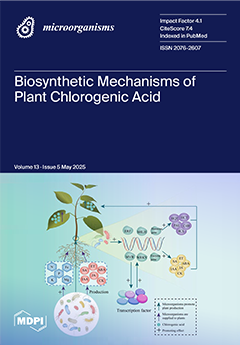Bioprotection in winemaking refers to the use of naturally occurring microorganisms—mainly non-
Saccharomyces yeasts—to inhibit the growth of spoilage microbes and reduce the need for chemical preservatives like sulfur dioxide (SO
2). Numerous studies have demonstrated the benefits of non-
Saccharomyces as
[...] Read more.
Bioprotection in winemaking refers to the use of naturally occurring microorganisms—mainly non-
Saccharomyces yeasts—to inhibit the growth of spoilage microbes and reduce the need for chemical preservatives like sulfur dioxide (SO
2). Numerous studies have demonstrated the benefits of non-
Saccharomyces as bioprotectants. However, the use of
Saccharomyces cerevisiae as a bioprotectant has been studied very little. Furthermore, it can offer many advantages for the production of sulfite-free wines. To test if
S. cerevisiae could be used in bioprotection, we compared the ability of different strains to inhibit the growth of
Brettanomyces bruxellensis and
Hanseniaspora uvarum. Among the strains tested, the
S. cerevisiae Sc54 strain isolated from the vineyard of the Bekaa plain was selected. To investigate its mechanisms of action, we analyzed its metabolite production, including acetic acid and ethanol. Taking into account the low levels of these metabolites and the lack of similar inhibition patterns in media supplemented with acetic acid and ethanol, it appears that other factors contribute to its antagonistic properties. Nutrient competition was ruled out as a factor, as the growth inhibition of
B. bruxellensis and
H. uvarum occurred rapidly within the first 24 h of co-culture. In this study, we explored the role of the
S. cerevisiae killer toxin (Sc54Kt) as a bioprotective agent against
H. uvarum and
B. bruxellensis spoilage yeasts. Purification procedures with ethanol allowed the extraction of Sc54Kt, yielding two concentrations (0.185 and 0.5 mg/mL). Remarkably, semi-purified Sc54Kt exhibited inhibitory effects at both concentrations under winemaking conditions, effectively controlling the growth and metabolic activity of the target spoilage yeasts. Overall, these findings demonstrate that
S. cerevisiae Sc54 not only exerts a strong bioprotective effect but also contributes to improving the quality of wine. The results suggest that
S. cerevisiae Sc54 is a promising bioprotective agent for mitigating spoilage yeasts in winemaking, offering a natural and effective alternative to conventional antimicrobial strategies.
Full article






